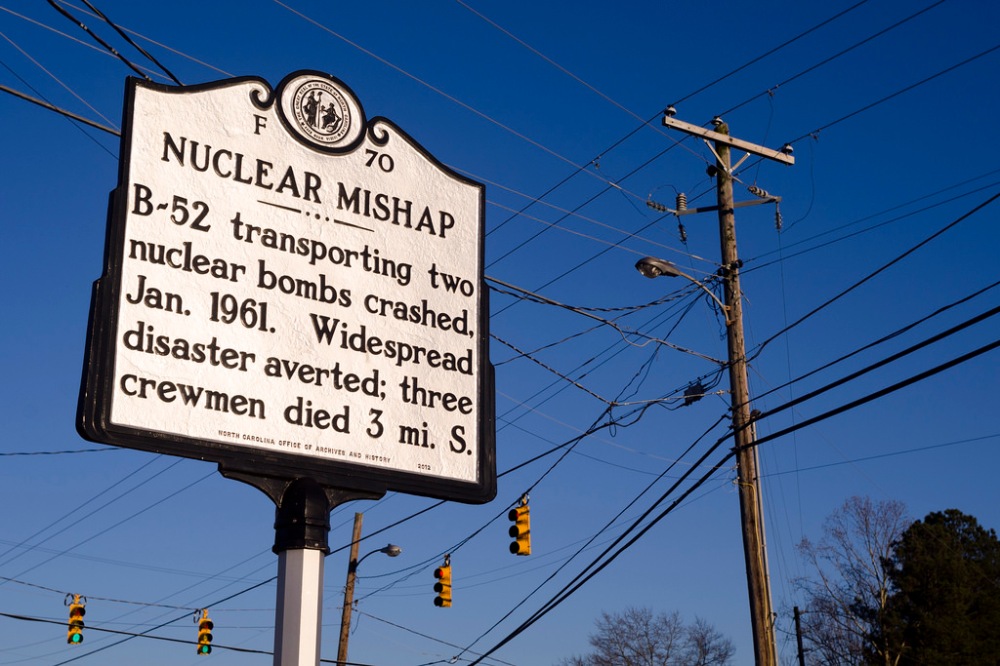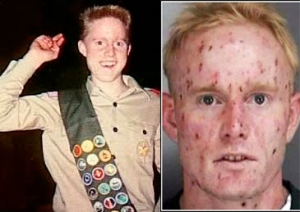“To every man is given the key to the gates of heaven. The same key opens the gates of hell. And so it is with science.”― Richard Feynman
Every cloud has a silver lining. Except nuclear mushroom clouds, which have a lining of Strontium-90, Caesium-137 and other radioactive isotopes. Upon detonation, atoms are literally gutted and glutton at temperatures exceeding that of the surface of our Sun. In the 1950s, Harold Edgerton‘s rapatronic camera caught nuclear fireballs less than a thousandth of second after detonation. Using a special magnetic shutter, each exposure lasted only a billionth of a second and captured an other-worldly creature, its energy vaporising the metal wires supporting its tower into stringing legs of plasma.
 When ‘Little Boy’ was detonated over Hiroshima only 1.38% of its uranium actually fissioned. The rest was blown away before that could happen, which means, as Eric Schlosser points out, the fission of merely 0.7 grams of uranium, that’s less than the weight of a banknote, was enough to kill 80,000 people and destroy two-thirds of city’s buildings. When a country has tens of thousands of nuclear weapons ready to go, accidents are a possibility. This was a problem during Cold War and it still a problem. What if there is a fire or a miscommunication or a rogue officer decides to set one off. Or what if someone just drops a warhead? How much risk is too much?
When ‘Little Boy’ was detonated over Hiroshima only 1.38% of its uranium actually fissioned. The rest was blown away before that could happen, which means, as Eric Schlosser points out, the fission of merely 0.7 grams of uranium, that’s less than the weight of a banknote, was enough to kill 80,000 people and destroy two-thirds of city’s buildings. When a country has tens of thousands of nuclear weapons ready to go, accidents are a possibility. This was a problem during Cold War and it still a problem. What if there is a fire or a miscommunication or a rogue officer decides to set one off. Or what if someone just drops a warhead? How much risk is too much?
The acceptable probability of the detonation of nuclear weapon in an accident is one in a million. In 2012, the odds of your dying in a commercial airliner accident were about one in forty million. So that’s even more remote than the accidental detonation of a nuclear weapon.
 Eureka comes from ancient Greek, meaning “I have found it!” And in Eureka, North Carolina you can find it, a giant sign says “Nuclear Mishap”. In January 23, 1961, a US B-52 bomber carrying two 4 megaton thermonuclear bombs over North Carolina tumbled from the sky. A loose lanyard in the cockpit snagged the bomb release switch. Each bomb contained a greater explosive yield than all munitions ever detonated by mankind combine. Luckily, they didn’t detonate. Lieutenant Jack ReVell discovered that only one safety mechanism didn’t fail that day. A single low voltage arming switch remained untouched during the crash. And that one switch is why, he explained in 2011, we don’t have a bay where North Carolina is today. The bombs were recovered… mostly. The Uranium-rich secondary of one of the bombs was never found. To this day it remains buried underground in North Carolina.
Eureka comes from ancient Greek, meaning “I have found it!” And in Eureka, North Carolina you can find it, a giant sign says “Nuclear Mishap”. In January 23, 1961, a US B-52 bomber carrying two 4 megaton thermonuclear bombs over North Carolina tumbled from the sky. A loose lanyard in the cockpit snagged the bomb release switch. Each bomb contained a greater explosive yield than all munitions ever detonated by mankind combine. Luckily, they didn’t detonate. Lieutenant Jack ReVell discovered that only one safety mechanism didn’t fail that day. A single low voltage arming switch remained untouched during the crash. And that one switch is why, he explained in 2011, we don’t have a bay where North Carolina is today. The bombs were recovered… mostly. The Uranium-rich secondary of one of the bombs was never found. To this day it remains buried underground in North Carolina. In 1994, a 17 year old David Hahn attempted to build a nuclear reactor in his mother’s backyard in Michigan. His reactor never reached critical mass but it did succeed in exposing his neighborhood to 1000 times the regular dosage of background radiation. It was declared a ‘Superfund hazardous materials cleanup‘ site and all of his work was confiscated by authorities and buried in Utah. In 2007 David Hahn was arrested for stealing smoke detectors from an apartment building, his face was covered with sores believed to be caused by constant exposure to radioactive materials.
In 1994, a 17 year old David Hahn attempted to build a nuclear reactor in his mother’s backyard in Michigan. His reactor never reached critical mass but it did succeed in exposing his neighborhood to 1000 times the regular dosage of background radiation. It was declared a ‘Superfund hazardous materials cleanup‘ site and all of his work was confiscated by authorities and buried in Utah. In 2007 David Hahn was arrested for stealing smoke detectors from an apartment building, his face was covered with sores believed to be caused by constant exposure to radioactive materials. Three days after ‘Little Boy’ was dropped on Hiroshima by the Enola Gay, Charles Sweeney was ordered to drop ‘Fatman’ on Kokura, Japan. He flew bockscar over the city for nearly an hour with the bomb bay doors open, but it was cloudy that day. Sweeney couldn’t achieve visual confirmation of the target and was forced to go to secondary target – Nagasaki, where 75,000 people died instead. Kokura was spared because of the clouds.
Three days after ‘Little Boy’ was dropped on Hiroshima by the Enola Gay, Charles Sweeney was ordered to drop ‘Fatman’ on Kokura, Japan. He flew bockscar over the city for nearly an hour with the bomb bay doors open, but it was cloudy that day. Sweeney couldn’t achieve visual confirmation of the target and was forced to go to secondary target – Nagasaki, where 75,000 people died instead. Kokura was spared because of the clouds.During World War 2, Japanese soldiers spot for their emperor in ways that made allied troops speechless. Kamikaze planes and torpedoes, driven by a single pilot, lost after use. When outnumbered, without hope, Japanese soldiers were reported to have thrown themselves off cliffs or swam out to sea to drown rather than surrendered. Even after two atomic bomb attacks, the Japanese Minister of War urged his people to continue fighting. But on August 14th, 1945, the Emperor of Japan overruled that decision and unconditionally surrendered. Men had leapt of off cliffs for him, but in his own words, the enemy has for the first time used cruel bombs. The heavy casualties are beyond measure.
Richard Feynman received the Nobel Prize in Physics in 1965. He also helped develop the first atomic bomb at Los Alamos. In “The Meaning of It All“, he wrote “Is science of any value?” And below that, “I think a power to do something is of value.” He elaborates by talking about keys. Everything we learned about the universe, everything we invent or discover within it, is a key to the gates of heaven. But the same key will also open the gates to hell. The Titan II Missile is great for delivering lethal nuclear warheads. But it also sent Gemini astronauts to space, preparing us for a mission to the Moon. Science doesn’t tell us how to use keys. It finds them or predicts them. How we use keys is up to us.





